A Guide to the Law of Securitisation in Australia - Clayton Utz
A Guide to the Law of Securitisation in Australia - Clayton Utz
A Guide to the Law of Securitisation in Australia - Clayton Utz
- No tags were found...
Create successful ePaper yourself
Turn your PDF publications into a flip-book with our unique Google optimized e-Paper software.
1 General overview <strong>of</strong> <strong>the</strong> nature <strong>of</strong>securitised <strong>in</strong>struments1.1 IntroductionThis section briefly reviews <strong>the</strong> nature <strong>of</strong> securitised <strong>in</strong>strumentsand <strong>the</strong> types <strong>of</strong> issuers <strong>in</strong> <strong>the</strong> <strong>Australia</strong>n marketplace. Theanalysis proceeds us<strong>in</strong>g <strong>the</strong> market’s dist<strong>in</strong>ction between equityand debt securities.1.2 Equity securitiesAn <strong>in</strong>ves<strong>to</strong>r <strong>in</strong> an equity security issued through a securitisationstructure holds a beneficial <strong>in</strong>terest <strong>in</strong> <strong>the</strong> underly<strong>in</strong>g mortgageor asset pool. Although <strong>the</strong> <strong>in</strong>strument may be described as abond or note, strictly speak<strong>in</strong>g an <strong>in</strong>ves<strong>to</strong>r receives a unit <strong>in</strong> a unittrust entitl<strong>in</strong>g it <strong>to</strong> a share <strong>of</strong> <strong>the</strong> <strong>in</strong>come and capital <strong>of</strong> <strong>the</strong> trustassets. The unit is structured <strong>to</strong> replicate <strong>the</strong> qualities <strong>of</strong> a debt<strong>in</strong>strument. Measures are put <strong>in</strong> place <strong>to</strong> ensure that <strong>in</strong>ves<strong>to</strong>rsreceive, on nom<strong>in</strong>ated dates, an amount equivalent <strong>to</strong> <strong>in</strong>terest(ie. a distribution <strong>of</strong> <strong>in</strong>come) and a repayment <strong>of</strong> pr<strong>in</strong>cipal (ie. aredemption <strong>of</strong> pr<strong>in</strong>cipal).The <strong>in</strong>itial securitisation structures <strong>in</strong> <strong>Australia</strong>, such as <strong>the</strong> earlyFANMAC Trusts, were based upon equity securities. However,<strong>the</strong> <strong>the</strong>n requirements <strong>of</strong> <strong>the</strong> former Insurance andSuperannuation Commission (ISC) favoured debt securities overequity securities. This resulted <strong>in</strong> <strong>the</strong>se structures be<strong>in</strong>g modifiedso that <strong>in</strong>ves<strong>to</strong>rs held a debt ra<strong>the</strong>r than an equity security. TheISC requirements no longer apply, however, new stamp dutyimpediments have developed that prevent <strong>the</strong> <strong>Australia</strong>-wideutilisation <strong>of</strong> equity securities. The impediments are brieflydiscussed <strong>in</strong> section 4.1.3 Debt securities1.3.1 Overview <strong>of</strong> debt securities <strong>in</strong> <strong>Australia</strong>nsecuritisationsUnder a debt security, <strong>the</strong> issuer allots <strong>in</strong>struments known asbonds, notes or commercial paper. Unlike equity securities,<strong>in</strong>ves<strong>to</strong>rs do not have an ownership <strong>in</strong>terest <strong>in</strong> <strong>the</strong> underly<strong>in</strong>gmortgage or asset pool. Instead, <strong>the</strong>y hold a promise by <strong>the</strong>issu<strong>in</strong>g vehicle <strong>to</strong> pay <strong>in</strong>terest and pr<strong>in</strong>cipal. This is typicallycomb<strong>in</strong>ed with a security <strong>in</strong>terest over <strong>the</strong> securitised assetsthrough a charge given by <strong>the</strong> issu<strong>in</strong>g vehicle <strong>to</strong> a security trusteefor <strong>the</strong> benefit <strong>of</strong> <strong>in</strong>ves<strong>to</strong>rs (and <strong>of</strong>ten for o<strong>the</strong>rs who providesupports for <strong>the</strong> structure). Such debt securities can bestructured on a bullet maturity or pass-through basis and asfloat<strong>in</strong>g rate or fixed rate securities.1.3.2 The issuers <strong>of</strong> debt securitiesDebt securities overseas tend <strong>to</strong> be issued only by specialpurpose corporations. This also occurs <strong>in</strong> <strong>Australia</strong>, but heretrustees also issue debt securities (this is particularly <strong>the</strong> case for<strong>Australia</strong>n mortgage securitisations). The securitised assets areheld on trust by <strong>the</strong> trustee and its liability under <strong>the</strong> debtsecurities is limited <strong>to</strong> <strong>the</strong> proceeds from <strong>the</strong> underly<strong>in</strong>g assetsthat are available <strong>to</strong> pay <strong>the</strong> securities <strong>in</strong> accordance with <strong>the</strong>relevant trust deed.The use <strong>of</strong> trusts <strong>to</strong> issue debt securities is largely conf<strong>in</strong>ed <strong>to</strong><strong>Australia</strong>. This <strong>in</strong> turn has led <strong>to</strong> <strong>Australia</strong>n securitisers and <strong>the</strong>iradvisers deal<strong>in</strong>g with a series <strong>of</strong> unique trust issues connectedwith this development. Some <strong>of</strong> <strong>the</strong>se are discussed <strong>in</strong> section 10.1.3.3 The form <strong>of</strong> debt securitiesDebt securities are typically issued <strong>in</strong> one <strong>of</strong> two forms.Physical securityUnder this, an <strong>in</strong>ves<strong>to</strong>r holds an <strong>in</strong>strument which itself conta<strong>in</strong>s<strong>the</strong> issuer’s debt obligation. The <strong>in</strong>strument can be transferred bydelivery or endorsement. Promissory notes are an example <strong>of</strong> thistype <strong>of</strong> debt security. While physical securities were oncecommon <strong>in</strong> <strong>the</strong> securitised market, <strong>the</strong>y are less so now for threereasons. The first is that <strong>the</strong> preparation and issue <strong>of</strong> <strong>in</strong>dividualsecurities are relatively cumbersome when compared <strong>to</strong> o<strong>the</strong>rmethods, particularly <strong>the</strong> electronic issue and trad<strong>in</strong>g <strong>of</strong>securities with<strong>in</strong> <strong>the</strong> Austraclear system. The second reason isthat <strong>the</strong> requirement <strong>of</strong> <strong>the</strong> trustees that <strong>the</strong>ir liability on suchsecurities be limited, and <strong>the</strong> similar (but slightly different)requirement imposed by <strong>the</strong> rat<strong>in</strong>g agencies <strong>in</strong> relation <strong>to</strong>segregated corporate issuers, mean that it is <strong>in</strong>creas<strong>in</strong>gly difficult<strong>to</strong> satisfy <strong>the</strong> strict legal requirements for such securities <strong>to</strong>qualify as promissory notes under <strong>the</strong> Bills <strong>of</strong> Exchange Act1909. This is discussed <strong>in</strong> fur<strong>the</strong>r detail <strong>in</strong> section 10. F<strong>in</strong>ally,section 126 <strong>of</strong> <strong>the</strong> Income Tax Assessment Act 1936 imposes adomestic withhold<strong>in</strong>g tax on <strong>in</strong>terest paid by a company on adebenture payable <strong>to</strong> <strong>the</strong> bearer where <strong>the</strong> company does notgive <strong>the</strong> Commissioner <strong>the</strong> name and address <strong>of</strong> <strong>the</strong> holder <strong>of</strong> <strong>the</strong>debenture. This tax discourages <strong>the</strong> use <strong>of</strong> bearer securities <strong>in</strong><strong>Australia</strong>.Registered securitiesThe o<strong>the</strong>r type <strong>of</strong> debt security is known as a registered security.The actual debt obligation <strong>of</strong> <strong>the</strong> issuer is constituted <strong>in</strong> aseparate document from <strong>the</strong> security itself. In <strong>the</strong> separatedocument, <strong>the</strong> issuer promises <strong>to</strong> pay <strong>the</strong> persons who from time<strong>to</strong> time appear on a register as holders <strong>of</strong> <strong>the</strong> relevant securities.8






